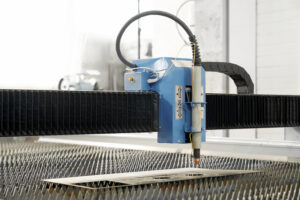The Treacherous Path of Hardware Product Design: Insights from WARNING MACHINES
Designing a physical product, whether it’s an intricate robot, a powerful electric bike, an innovative smart device, or any complex piece of machinery, is inherently fraught with challenges. Unlike software, where changes can be deployed with a click, errors in hardware design manifest as costly rework, extensive delays, and often, complete project failure. From the initial spark of an idea to overdesigning features, or underestimating manufacturing limits, to overlooking crucial testing phases, mistakes in hardware product design are notoriously expensive and time-consuming.
At WARNING MACHINES, with our deep expertise in end-to-end hardware development, prototyping, and manufacturing, we’ve witnessed countless teams navigate this complex landscape. Our experience has provided us with invaluable insights into the common pitfalls that even the brightest minds can fall into.
Here are the five most critical mistakes we consistently observe hardware startups and established product teams make during their design journey and more importantly, our expert guidance on how to avoid them to ensure your project’s success.
❌ Hardware Product Design Mistake #1: Designing Without Manufacturability in Mind (Ignoring DFM)
One of the most frequent and costly errors is to design a product solely based on its aesthetic appeal or theoretical function, without considering the realities of how it will be manufactured. A beautiful 3D render doesn’t guarantee a buildable product.
Common issues we see:
- Using exotic or hard-to-source materials: Designing with materials that are rare, prohibitively expensive, or have extremely long lead times, causing supply chain bottlenecks and cost overruns.
- Ignoring manufacturing tolerances: Creating designs with extremely tight tolerances that are impossible or incredibly expensive to achieve with standard CNC machining, injection molding, or other production methods. This leads to high scrap rates and assembly issues.
- Complex geometries that drive up cost: Designing intricate shapes or internal structures that require specialized, slow, and expensive manufacturing processes, unnecessarily inflating unit costs.
- Unsuitable assembly methods: Designing parts that are difficult to align, fasten, or assemble efficiently on a production line, leading to manual labor, errors, and increased time per unit.
✅ The WARNING MACHINES Fix: Embrace DFM (Design for Manufacturability) Early
The solution lies in integrating Design for Manufacturability (DFM) principles from the very first CAD sketch. At WARNING MACHINES, we advocate for and practice a DFM-centric approach. We recommend:
- Collaborate with your manufacturer early: Our engineers work with you from the conceptual phase, providing crucial insights into material selection, process limitations, and cost implications.
- Simplify geometry where possible: Streamline designs to be compatible with standard manufacturing techniques (e.g., avoiding undercuts in injection molding, designing for efficient CNC toolpaths).
- Understand material properties and availability: Choose materials that meet performance needs while being readily available and cost-effective for your target production volume.
- Design for assembly (DFA): Consider how parts will fit together easily and efficiently, minimizing assembly time and potential errors.

❌ Hardware Product Design Mistake #2: Skipping the Prototype Phase (The Leap of Faith)
Many eager teams, fueled by excitement for their concept, are tempted to jump directly from stunning 3D renders or theoretical simulations to final production. This “leap of faith” is precarious and almost always leads to major setbacks.
Why skipping prototyping in Hardware Product Design is risky:
- Real-world tolerances don’t match CAD perfection: What looks perfect in a digital model often doesn’t account for real-world material properties, machining variations, or assembly stresses.
- Assembly problems don’t show up until it’s too late: Components that fit perfectly in CAD might clash physically or be impossible to assemble efficiently in reality.
- Electronics may interfere with mechanics: Electromagnetic interference, signal noise, or physical space conflicts between electronic and mechanical components are often only discovered during physical testing.
- User experience flaws remain hidden: Ergonomics, button feel, and overall usability can only be truly evaluated with a physical prototype.
✅ The WARNING MACHINES Fix: Always Prototype, Iterate, and Validate
Never skip the prototype phase. Always build physical versions, even rough ones, to validate your ideas. WARNING MACHINES champions rapid prototyping as a crucial risk-mitigation strategy. We help you utilize effective methods such as:
- 3D Printing: For quickly creating physical models to test form, fit, and basic assembly.
- Foam or Cardboard Models: For early ergonomic and size validation.
- Arduino or Raspberry Pi-based Testbeds: For quickly validating electronic functionality and fundamental software interactions before custom PCB development.
- Low-volume CNC parts: For functional prototypes requiring higher fidelity and specific material properties.
This iterative approach, central to our hardware development services, enables you to “fail fast” and learn quickly, ultimately saving you immense time and money in the long run.
❌ Hardware Product Design Mistake #3: Over-Engineering
The desire to pack in too many features, mechanisms, or unnecessary complexities is a classic recipe for delays, budget overruns, and eventual product failure. This is often known as “feature creep.”
Typical signs of over-engineering in Hardware Product Design :
- Multiple redundant parts: Using several components to achieve a function that could be done with one simpler part.
- Unnecessary sensors or motor systems: Adding components that don’t contribute significantly to the core value proposition or are rarely used by the end-user.
- Complex and fragile wiring: Intricate wiring harnesses that are difficult to assemble, debug, and prone to failure in real-world conditions.
- Bloated software features: While a software issue, it often reflects a lack of focus on the core hardware purpose.
✅ The WARNING MACHINES Fix: Focus on the MVP (Minimum Viable Product)
Stick rigorously to your Minimum Viable Product (MVP) definition. Focus on the core functionality that delivers primary value to the user. Add complexity only after the core functions are stable, rigorously tested, and validated in the market.
- Define core functionalities early: Clearly articulate what the product absolutely must do.
- Prioritize ruthlessly: Be willing to defer non-essential features to future versions.
- Iterate on simplicity: Often, the most elegant solutions are the simplest ones. Our engineers help simplify designs for efficiency and reliability.
❌ Hardware Product Design Mistake #4: Underestimating Power & Heat (The Silent Killers)
It’s easy to design a beautiful enclosure and powerful electronics, but forget about the fundamental laws of physics. Many teams underestimate the temperature of components when they operate under load or the rate at which a battery can drain in real-world usage.
Things to watch out for:
- Lack of Adequate Heat Dissipation in Hardware Product Design: Enclosures designed without proper ventilation, heat sinks, or thermal pathways can lead to component overheating, reduced lifespan, and performance degradation.
- Undersized batteries for motor-heavy applications: Underestimating the power draw of motors, displays, or wireless modules can result in significantly shorter battery life than anticipated, leading to user dissatisfaction.
- Insufficient airflow in compact builds. Hardware Product Design: Trying to cram too many components into a small space without considering airflow can create thermal hotspots.
- Power regulation inefficiencies: Poorly designed power conversion circuits can waste energy as heat.
✅ The WARNING MACHINES Fix: Rigorous Thermal and Power Testing
Always test your power system under realistic load conditions. Always leave a healthy margin in your thermal and electrical design. At WARNING MACHINES, our electronics development expertise includes:
- Thorough power system analysis: Calculating power consumption for all components under various operational modes.
- Thermal simulations and testing: Using specialized tools to predict and validate heat dissipation, ensuring components stay within safe operating temperatures.
- Selecting appropriate battery chemistries and capacities: Matching the power source to the product’s energy demands and desired runtime.
- Designing for efficient power management: Optimizing circuits for minimal power loss and efficient heat transfer.
❌ Hardware Product Design Mistake #5: Poor Documentation and Version Control (The Recipe for Chaos)
In hardware product design, changes happen rapidly. Components evolve, designs are revised, and team members contribute at different times. If you’re not meticulously tracking these changes, it quickly leads to chaos, errors, and wasted effort.
You risk:
- Manufacturing from outdated files: Producing an entire batch of products based on an old design revision, leading to unusable inventory.
- Conflicts between electrical and mechanical teams: Discrepancies between PCB layouts and enclosure designs because the teams are not working from the duplicate versioned files.
- Losing track of part suppliers or specifications: Inability to re-order specific components or replicate previous builds due to missing or disorganized information.
- Difficulty in debugging: Without a clear history of changes, pinpointing when and why a problem occurred becomes incredibly hard.
✅ The WARNING MACHINES Fix: Implement Robust Version Control and Documentation
Utilize rigorous version control tools and establish a clear documentation strategy from day one.
- Version control tools for CAD and electronics projects: Tools like Git (used with platforms such as GitHub, GitLab, and Bitbucket) are crucial for tracking every change in mechanical (CAD files), electrical (schematics, PCB layouts), and firmware code.
- Centralized documentation system: Maintain all critical project information in a shared, accessible system. This includes:
- BOMs (Bills of Materials): Comprehensive lists of all parts, quantities, and suppliers.
- Wiring Diagrams: Clear schematics for all electrical connections.
- Assembly Instructions: Step-by-step guides for putting the product together.
- Test Results: Records of all validation tests and their outcomes.
- Design Change Logs: Documenting every revision and the reason for it.
Hardware Product Design to Succeed with WARNING MACHINES
Hardware product design isn’t just about creative ingenuity; it’s about meticulous planning, disciplined execution, and learning from potential pitfalls. Avoiding these five critical mistakes can save your project weeks, months, and substantial financial resources in rework and missed opportunities.
At WARNING MACHINES, we don’t just provide Hardware Product Design services; we partner with you to design to succeed. Our integrated approach, spanning prototyping, CNC machining, 3D printing, PCB development, and low-volume manufacturing, is built on years of experience in overcoming these very challenges. We embed DFM principles, champion iterative prototyping, and guide you through every technical hurdle.
Let us know what you’re building. We’ll help you make it smarter, faster, and more efficiently specially in Hardware Product Design
Ready to turn your vision into a robust, market-ready product? Contact WARNING MACHINES today for a consultation.


